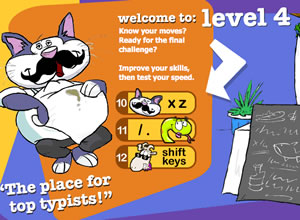

This is because normal PlayStation games do not require such input, and because D-pads are not usually designed to physically permit such input. Most PlayStation-PC adapters will not register Up and Down, or Left and Right, simultaneously initially, although they are common "jumps" in dance games. Problems are often encountered when attempting to use a PlayStation pad with a computer simulator. The advantages of a solid state design is that they do not require pressure to activate, eliminating moving parts that might break down and keeping dirt from getting into the mechanism. A proximity sensor is used to detect a player's steps on the pad. "Solid State" pads replace the usual mechanical switch and contact used in other hard pads.
Dance mat typing plus#
Hard pads are used in all arcade versions of music games that employ dance pads, and often serve as the nec plus ultra for DIY Gamers that attempt to construct "Homebrew pads." Many Homebrew kits are ultimately instruction guides for converting soft pads into hard pads, although Homebrew hard pads often feature additional functions such as additional inputs (see below). Manufacturers of hard pads include DDRgame, Cobalt Flux, MyMyBox, Brown Box, RedOctane (ceased production as of February 2010 due to company termination) and Naki International. Other hard pads can be purchased for home use with a video game system the prices can be around US$100 to $350 ($200–$600 for double pads) - $700 to $1000+ online. Arcade machines use very durable metal pads that are designed for heavy use. "Hard" pads are usually constructed with metal (and sometimes wood) for durability, and usually come with a raised bar behind the player. The arcade version of Dance Dance Revolution's two-player dance platform is an example of a hard pad. It is also possible to modify a pad by attaching it to a hard surface and optionally covering it with clear material this can increase pad life and keep it from slipping around. These pads generally cost between $40 and $100. Certain brands of foam pads put raised plastic sections under the directional buttons to allow them to be more easily felt by a player's feet, so as to help keep him centered on the pad. The inserts usually ship as three or six puzzle pieces (to allow for a smaller box) which fit together using a dovetail joint and slide into the dance pad, which then zips closed around the foam. Some soft pads contain stiff foam inserts of the dense or hard varieties to provide more stability and durability. OEM manufacturers include Topway (manufacturer of RedOctane pads), Futime, and many others. Manufacturers of soft pads include Konami, BNSUSA, RedOctane, Intec, Mad Catz ( Beat Pad), MyMyBox, Naki International, and Nintendo ( Action Pad). They are not usually durable and may wear out easily, but for light use they are quite suitable. They are good for beginners to dance games or casual use, but they have a tendency to move around and wrinkle up during gameplay (unless "modded", such as by gluing or taping them to the top of a piece of plywood or the bottom of a transparent office chair mat). "Soft" pads are thin and made of plastic. The 1987 Power Pad is a classic example of the soft pad. These home pads are specifically made for systems such as the GameCube, Wii, Dreamcast (Japan only), PlayStation, PlayStation 2 and Xbox, but can also be used in computer simulators such as StepMania through the use of special adapters. Popular arcade games such as Dance Dance Revolution, In the Groove, Pump It Up, and StepManiaX use large steel dance platforms connected to the arcade cabinet, whereas versions for home consoles usually use smaller (often flexible) plastic pads.

Pairs of dance pads often are joined, side by side, for certain gameplay modes. Some dance pads also have extra buttons outside the main stepping area, such as "Start" and "Select". Most dance pads are divided into a 3×3 matrix of square panels for the player to stand on, with some or all of the panels corresponding to directions or actions within the game. Dance platform for PlayStation version of DDR, with a hand controller in the lower left square for scaleĪ dance pad, also known as a dance mat or dance platform, is a flat electronic game controller used for input in dance games.


 0 kommentar(er)
0 kommentar(er)
